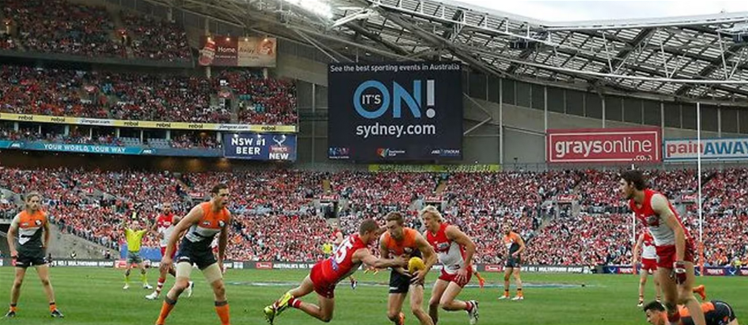The Australian Football League (AFL) has built data visualisations and a machine-learning model to support campaigns by the 18 clubs to grow and retain their member and fanbases.

The suite of tools predicts the likelihood of members renewing their memberships, maps fans into hundreds of categories, including statistical areas drawn from the census, generates daily performance reports and evaluates marketing campaigns.
This is about more than just boosting attendance at elite games or converting fans to members: Auskick and semi-professional clubs’ data informs initiatives to make football clubs more popular in different local areas; answering questions like ‘What’s the optimal location for a new community sports ground?’
AFL head of data and analytics Elisa Koch and data visualisation lead Penny Privett unveiled AFL’s “Fan Data Service” - which took their respective teams three years to build - last month.
“We have four key data products within the ‘Fan Data Service’ offering’”, Koch told the Melbourne Business Analytics Conference.
“This includes self-serve reporting through Tableau, our machine learning capability, a mapping capability and fan share.
"Fan share is the ability for clubs to have access to their own fan data in a secure and compliant way.”
There are more than 700 analysts from different clubs who have registered AFL Tableau accounts to access the tools, Koch said.
She added that because “they know their fans and members the best”, her “12-member team” built a distributed model that relies on clubs leveraging it as they see fit.
“We built a foundation and then we let our end users take that foundation and customise it to their requirements and their strategies, whatever they may be.”
Single source of truth
Privett said that before the Fan Data Service, the closest thing to a “single source of truth” clubs accessed were SAP Crystal Reports, which she wanted to replace with a Tableau dashboard.
“Crystal Reports is just tables and numbers, or the fancy ones have 3D pie charts…we needed to provide more advanced and more visual insights; so we built out the daily membership report for clubs; that was our first mission," she said.
“We built these base dashboards that they can either use off-the-shelf or they can take them away and customise them.”
Everyone who signed up for the daily report from “the club’s CEO and exec level down to frontline membership teams” received it at 9:00 in their inbox every morning, Privett said.
“It covers data on ‘What's our club membership number?’ ‘How are we tracking towards our targets?’, ‘How are we tracking compared to year over year?’, and any other KPIs that the club wants to add to it.”
Predicting membership renewal likelihood
Koch noted that because “sport is the industry with arguably the most loyal and passionate customers relative to any other industry” it generates some of the richest data about its customers.
“Luckily, within the history of the sport, fans have engaged in so many different ways. We really are thankful for that because it means we can really understand who these fans are and all their different engagement points."
The AFL wanted to give clubs “a 360 view” of potential fans, fans and members, to visually map and filter them into categories so that clubs could focus marketing campaigns and other resources into demographics, media and locations most likely to return the highest membership growth and retention.
However, AFL’s rich customer databases lacked the most useful data point - individual club members’ propensity not to renew - which had to be predicted using existing datasets.
“So we built a machine learning model that assigned a propensity score to all members: all 1.2 million-odd members,” Privett said.
The model’s input data included “their membership product type, how many games they attend, whether they’re buying tickets separately, what kinds of purchases they’re making, whether they’re interacting with tipping - anything that we could match back to a specific customer. We put all of those factors into a machine learning model.”
From an output perspective, on one side of the spectrum are “members most likely to renew that we want to nurture but probably don't have to work too hard to on,” she said.
On the other are “those that are most likely to churn out; perhaps they got a complimentary membership as part of Auskick.”
Clubs tended to focus on “the [cohort] in the middle,” Privett said: “Those that are likely to churn but if we do some targeted, personalised contact with them we may be able to change the tide and retain them as members.”
Mapping fans with Tableau
Privett said that the AFL's dashboards didn’t stop at grading members on their propensity to churn; clubs can also customise and adjust the churn propensity thresholds and focus campaigns on more specific subgroups.
“Maybe they want to play around with who they consider most likely to renew and most likely to churn; they've got the option to filter out anyone who's received a complimentary membership; maybe they're only interested in looking at those who’ve got paid memberships," Privett said.
Enriching maps with statistical area data
Prior to Fan Data Service, AFL mapped fans to postcodes, but the analytics team enriched its datasets by mapping them to more precise statistical areas provided by the Australian Bureau of Statistics (ABS), Privett said.
“We've got our membership database and we've had their reference geocoded; we've got better latitudes and longitudes, and then we round it to three decimal places, for privacy purposes; we also added statistical areas, which if you’re not familiar with are ABS’s small segments of about 400 people and it's pretty consistent across the country," Privett said.
“ABS census data is hundreds of spreadsheets with hundreds of columns… I went through and picked out the 500-odd metrics that I felt were relevant to what we were looking at and built them into a usable data source, and then put that all together.”
Privett presented the audience with a slide showing a dashboard that she said combined member metrics and census metrics.
“So right now it's coloured by the number of members in any of those statistical areas, but clubs could look at median income; they could look at the median age; they could look at cultural diversity.”
Data for community engagement growth
The statistical area data is of particular use to AFL projects aimed at making football more popular in local areas, Koch said.
“Game development is a team charged with growing grassroots community football; so Auskick etc," she said.
“The AFL made a commitment earlier this year to enshrine 10 percent of our revenue - forever - to growing grassroots community football, and therefore, we want to ensure that, as a data team, we are also strategically focused on supporting that team.”
Privett added that the Fan Data Service dashboard helped “the game development team figure out where they want to build the next [sporting] facility and what local governments they want to work with to help them build facilities for communities.”
The team used the dashboard to answer questions like: “‘Where do we have schools?’, ‘Where do we have community football programs’?, ‘Where do people live in relation to them’? and “Do we need to move things around?
“We've got the registrations of Auskick and community football players and we've had them geocoded and then we put that mapping capability in to see: ‘Is there a gap between all the Auskickers being over here but all the centres being over there?’
"‘Do we need to build a centre over here?’”
Investing in analytics for NSW growth
The capabilities that the Melbourne-headquartered league has built its clubs are part of a broader growth strategy that has also seen AFL open its inaugural Parramatta-based ‘Expansion Hub’ this year.
The hub aims to increase AFL participation in Greater Sydney, boost the Greater Western Sydney Giants’ and Sydney Swans’ consumer revenues and convert NSW’s non-fans into first-time participants, attendees, fans and members.
AFL is also looking to hire a data insights manager for the hub to “develop and maintain a Greater Sydney data warehouse and Salesforce CRM, which consolidates consumer, participant, schools and other relevant data,” according to a recent job posting.
The manager will also “support the expansion hub marketing team to develop and execute a Salesforce marketing automation program – creating automated and personalised campaigns to drive acquisition and retention.”




















